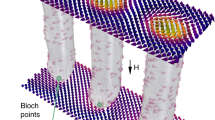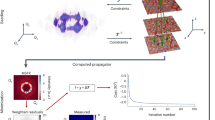Abstract
Magnetic skyrmions are topologically stable swirling spin textures that appear as particle-like objects in two-dimensional (2D) systems. Here, utilizing scalar magnetic X-ray tomography under applied magnetic fields, we report the direct visualization of the three-dimensional (3D) shape of individual skyrmion strings in the room-temperature skyrmion-hosting non-centrosymmetric compound Mn1.4Pt0.9Pd0.1Sn. Through the tomographic reconstruction of the 3D distribution of the [001] magnetization component on the basis of transmission images taken at various angles, we identify a skyrmion string running through the entire thickness of the sample, as well as various defect structures, such as the interrupted and Y-shaped strings. The observed point defect may represent the Bloch point serving as an emergent magnetic monopole, as proposed theoretically. Our tomographic approach with a tunable magnetic field paves the way for direct visualization of the structural dynamics of individual skyrmion strings in 3D space, which will contribute to a better understanding of the creation, annihilation and transfer of these topological objects.
This is a preview of subscription content, access via your institution
Access options
Access Nature and 54 other Nature Portfolio journals
Get Nature+, our best-value online-access subscription
$29.99 / 30 days
cancel any time
Subscribe to this journal
Receive 12 print issues and online access
$259.00 per year
only $21.58 per issue
Buy this article
- Purchase on Springer Link
- Instant access to full article PDF
Prices may be subject to local taxes which are calculated during checkout




Similar content being viewed by others
Data availability
The data presented in the current study are available from the corresponding authors on reasonable request.
References
Mühlbauer, S. et al. Skyrmion lattice in a chiral magnet. Science 323, 915–919 (2009).
Yu, X. Z. et al. Real-space observation of a two-dimensional skyrmion crystal. Nature 465, 901–904 (2010).
Rößler, U. K. et al. Spontaneous skyrmion ground states in magnetic metals. Nature 442, 797–801 (2006).
Fert, A., Reyren, N. & Cros, V. Magnetic skyrmions: advances in physics and potential applications. Nat. Rev. Mater. 2, 17031 (2017).
Nagaosa, N. & Tokura, Y. Topological properties and dynamics of magnetic skyrmions. Nat. Nanotechnol. 8, 899–911 (2013).
Jonietz, F. et al. Spin transfer torques in MnSi at ultralow current densities. Science 330, 1648–1651 (2010).
Yu, X. Z. et al. Skyrmion flow near room temperature in an ultralow current density. Nat. Commun. 3, 988 (2012).
Jiang, W. et al. Blowing magnetic skyrmion bubbles. Science 349, 283–286 (2015).
Woo, S. et al. Observation of room-temperature magnetic skyrmions and their current-driven dynamics in ultrathin metallic ferromagnets. Nat. Mater. 15, 501–506 (2016).
Neubauer, A. et al. Topological Hall effect in the A phase of MnSi. Phys. Rev. Lett. 102, 186602 (2009).
Schulz, T. et al. Emergent electrodynamics of skyrmions in a chiral magnet. Nat. Phys. 8, 301–304 (2012).
Zhang, X. et al. Magnetic skyrmion logic gates: conversion, duplication and merging of skyrmions. Sci. Rep. 5, 9400 (2015).
Song, K. M. et al. Skyrmion-based artificial synapses for neuromorphic computing. Nat. Electron. 3, 148–155 (2020).
Milde, P. et al. Unwinding of a skyrmion lattice by magnetic monopoles. Science 340, 1076–1080 (2013).
Kagawa, F. et al. Current-induced viscoelastic topological unwinding of metastable skyrmion strings. Nat. Commun. 8, 1332 (2017).
Yokouchi, T. et al. Current-induced dynamics of skyrmion strings. Sci. Adv. 4, eaat1115 (2018).
Koshibae, W. & Nagaosa, N. Dynamics of skyrmion in disordered chiral magnet of thin film form. Sci. Rep. 9, 5111 (2019).
Seki, S. et al. Propagation dynamics of spin excitations along skyrmion strings. Nat. Commun. 11, 256 (2020).
Seki, S., Yu, X. Z., Ishiwata, S. & Tokura, Y. Observation of skyrmions in a multiferroic material. Science 336, 198–201 (2012).
Tokunaga, Y. et al. A new class of chiral materials hosting magnetic skyrmions beyond room temperature. Nat. Commun. 6, 7638 (2015).
Kézsmárki, I. et al. Néel-type skyrmion lattice with confined orientation in the polar magnetic semiconductor GaV4S8. Nat. Mater. 14, 1116–1122 (2015).
Nayak, A. K. et al. Magnetic antiskyrmions above room temperature in tetragonal Heusler materials. Nature 548, 561–566 (2017).
Zhang, S. et al. Reciprocal space tomography of 3D skyrmion lattice order in a chiral magnet. Proc. Natl Acad. Sci. USA 115, 6386–6391 (2018).
Park, H. S. et al. Observation of the magnetic flux and three-dimensional structure of skyrmion lattices by electron holography. Nat. Nanotechnol. 9, 337–342 (2014).
Moreau-Luchaire, C. et al. Additive interfacial chiral interaction in multilayers for stabilization of small individual skyrmions at room temperature. Nat. Nanotechnol. 11, 444–448 (2016).
Birch, M. T. et al. Real-space imaging of confined magnetic skyrmion tubes. Nat. Commun. 11, 1726 (2020).
Yu, X. Z. et al. Real-space observation of topological defects in extended skyrmion-strings. Nano Lett. 20, 7313–7320 (2020).
Donnelly, C. et al. Three-dimensional magnetization structures revealed with X-ray vector nanotomography. Nature 547, 328–331 (2017).
Suzuki, M. et al. Three-dimensional visualization of magnetic domain structure with strong uniaxial anisotropy via scanning hard X-ray microtomography. Appl. Phys. Exp. 11, 036601 (2018).
Hierro-Rodriguez, A. et al. Revealing 3D magnetization of thin films with soft X-ray tomography: magnetic singularities and topological charges. Nat. Commun. 11, 6382 (2020).
Donnelly, C. et al. Imaging three-dimensional magnetic systems with X-rays. J. Phys. Condens. Matter 32, 213001 (2020).
Schütte, C. & Rosch, A. Dynamics and energetics of emergent magnetic monopoles in chiral magnets. Phys. Rev. B 90, 174432 (2014).
Vir, P. et al. Anisotropic topological Hall effect with real and momentum space Berry curvature in the antiskrymion-hosting Heusler compound Mn1.4PtSn. Phys. Rev. B 99, 140406(R) (2019).
Ma, T. et al. Tunable magnetic antiskyrmion size and helical period from nanometers to micrometers in a D2d Heusler compound. Adv. Mater. 32, 2002043 (2020).
Jena, J. et al. Elliptical Bloch skyrmion chiral twins in an antiskyrmion system. Nat. Commun. 11, 1115 (2020).
Srivastava, A. K. et al. Observation of robust Néel skyrmions in metallic PtMnGa. Adv. Mater. 32, 1904327 (2020).
Radon, J. On the determination of functions from their integral values along certain manifolds. IEEE Trans. Med. Imaging 5, 170–176 (1986).
Gordon, R., Bender, R. & Herman, G. T. Algebraic reconstruction techniques (ART) for three-dimensional electron microscopy and X-ray photography. J. Theor. Biol. 29, 471–476 (1970).
Rybakov, F. N. et al. New type of stable particlelike states in chiral magnets. Phys. Rev. Lett. 115, 117201 (2015).
Zheng, F. et al. Experimental observation of chiral magnetic bobbers in B20-type FeGe. Nat. Nanotechnol. 13, 451–455 (2018).
Feldtkeller, E. Mikromagnetisch stetige und unstetige Magnetisierungskonfigurationen. Z. Angew. Phys. 19, 530–536 (1965).
DaCol, S. et al. Observation of Bloch-point domain walls in cylindrical. Phys. Rev. B 89, 180405(R) (2011).
Kanazawa, N. et al. Critical phenomena of emergent magnetic monopoles in a chiral magnet. Nat. Commun. 7, 11622 (2016).
Fujishiro, Y. et al. Large magneto-thermopower in MnGe with topological spin texture. Nat. Commun. 9, 408 (2018).
Donnelly, C. et al. Experimental observation of vortex rings in a bulk magnet. Nat. Phys. 17, 316–321 (2020).
Suzuki, M. et al. Magnetic microscopy using a circularly polarized hard-X-ray nanoprobe at SPring-8. Synchrotron Radiat. News 33, 4–11 (2020).
Acknowledgements
The authors thank L. Peng, X. Z. Yu, N. Nagaosa, T. Arima and A. Kikkawa for enlightening discussions and experimental help. This work was partly supported by Grants-in-Aid for Scientific Research (grant nos. 18H03685, 18K14117, 20H00349, 21H04440, 21H04990, 21K18595, 21K13876) and Grant-in-Aid for Specially Promoted Research (15H05702) from JSPS, PRESTO (grant no. JPMJPR18L5, JPMJPR20B4) and CREST (grant no. JPMJCR1874) from JST, Asahi Glass Foundation and Murata Science Foundation. The synchrotron radiation experiments were performed with the approval of the Japan Synchrotron Radiation Research Institute (JASRI) (proposal nos. 2018A2067, 2019B1173 and 2020A2057).
Author information
Authors and Affiliations
Contributions
S.S., M.S. and T.O. planned the project. S.S., M.S., M.I. and T.O. performed the scalar magnetic X-ray tomography measurements. R.T., N.D.K., S.S., and Y.T. prepared the samples. M.I. and Y.S. supported the sample characterization. M.S. performed the reconstruction of the scalar magnetic tomography data. S.S. and M.S. analysed the reconstructed images and performed the simulation of tomographic reconstruction. K.S., S.S. and W.K. performed the theoretical calculations. S.S. wrote the manuscript with the support from M.S. and T.O. All authors discussed the results and commented on the manuscript.
Corresponding authors
Ethics declarations
Competing interests
The authors declare no competing interests.
Additional information
Peer review information Nature Materials thanks Daniel Haskel and the other, anonymous, reviewer(s) for their contribution to the peer review of this work.
Publisher’s note Springer Nature remains neutral with regard to jurisdictional claims in published maps and institutional affiliations.
Supplementary information
Supplementary Information
Supplementary Figs. 1–8 and Notes 1–9.
Supplementary Video 1
A series of XMCD images taken from various angles −90∘ ≤ θ ≤ 90∘ with 5∘ steps. The images taken at selected θ values are shown in Fig. 2 in the main text.
Supplementary Video 2
360∘ view of the experimentally reconstructed mc(r) profiles. The definition of background colour is the same as in Fig. 3b,c in the main text.
Supplementary Video 3
Slice animation of experimentally reconstructed mc(r) profiles, where the slice position is changed as a function of time. The selected slice images are shown in Fig. 3b,c in the main text.
Rights and permissions
About this article
Cite this article
Seki, S., Suzuki, M., Ishibashi, M. et al. Direct visualization of the three-dimensional shape of skyrmion strings in a noncentrosymmetric magnet. Nat. Mater. 21, 181–187 (2022). https://doi.org/10.1038/s41563-021-01141-w
Received:
Accepted:
Published:
Issue Date:
DOI: https://doi.org/10.1038/s41563-021-01141-w
This article is cited by
-
Magnetostatic interaction between Bloch point nanospheres
Scientific Reports (2023)
-
Three-dimensional neutron far-field tomography of a bulk skyrmion lattice
Nature Physics (2023)
-
Topology-induced chiral photon emission from a large-scale meron lattice
Nature Electronics (2023)
-
Bloch points and topological dipoles observed by X-ray vector magnetic tomography in a ferromagnetic microstructure
Communications Physics (2023)
-
A fast magnetic vector characterization method for quasi two-dimensional systems and heterostructures
Scientific Reports (2023)



